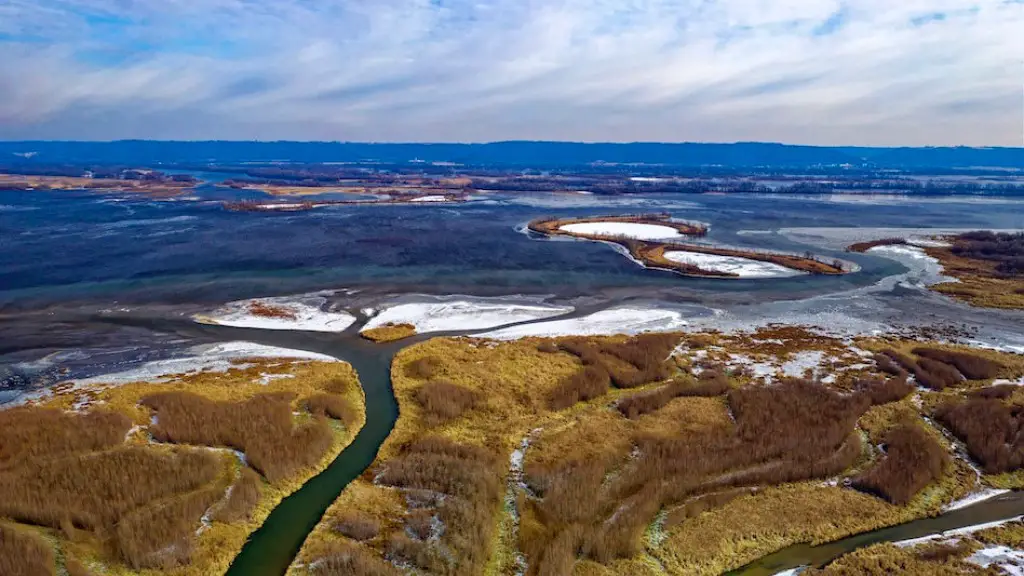The Mississippi River is one of the world’s largest rivers, stretching over 3,000 miles from Minnesota to the Gulf of Mexico. It is an important part of American history and culture, and has been used for trading and transportation for centuries. But just how much water does the Mississippi River hold? Estimates vary, but the most reliable estimate is that the Mississippi River holds an average of 7.2 trillion gallons of water.
This amount is enough to cover New York State three inches deep or the entire state of Louisiana with a two-foot layer of water. While the amount of water held in the Mississippi River can fluctuate depending on a number of factors, there is one constant: it never runs dry. This is due to the river’s continuous flow, which is supplied by tributaries from all over the Midwest.
The Mississippi River is also an important source of freshwater for the Gulf of Mexico, providing approximately 20 percent of the total freshwater input to the Gulf. It also provides irrigation for thousands of acres of land, supports commercial navigation, and provides a variety of recreational opportunities for paddlers, anglers, and sightseers. As such, the health of the Mississippi River is of utmost importance to the ecosystem of the Gulf of Mexico.
The amount of water held in the Mississippi River has an effect on the entire region, particularly in times of drought. When water levels drop or become stagnant, the quality of water downstream can be affected, making it unsuitable for drinking. Low water levels can also affect ecosystems, aquatic life, and other species that rely on the river. In recent years, over-abstraction and drought have had effects on water levels in the Mississippi River, leading to a decrease in water flow and stagnation in some sections.
River management is a key factor in preserving the health of the Mississippi. Organizations like the Army Corps of Engineers and the US Geological Survey work hard to monitor the river’s water levels and the surrounding ecosystems. Government agencies also work with local organizations and communities to reduce nutrient and sediment inputs, which can cause algal blooms, low oxygen levels, and flooding. Creating and maintaining reservoirs can also be a useful way to conserve Mississippi River water.
The health of the river is also affected by climate change. Warmer temperatures in the summer months lead to increased evaporation and decreased rainfall, which can lead to lower water levels. The melting of snow in winter can also reduce water levels, leading to droughts and other adverse effects on the river and its tributaries. Ultimately, managing the Mississippi River and its water levels is essential to preserve its health and the health of the Gulf of Mexico.
How does the Mississippi River affect other rivers systems?
The Mississippi River is part of a vast network of rivers and watersheds, stretching from the Rocky Mountains in the west to the Atlantic Ocean in the east. As such, the health of the Mississippi River has a major impact on the health of other rivers and watersheds in the US and Canada. The effects of over-abstraction and drought, for example, can be felt in other rivers and watersheds, leading to decreased water flow, sedimentation, and aquatic life disruption. Low water levels in the Mississippi can also affect flood management practices in other regions, as the river serves as an important natural buffer in the event of flooding.
The Mississippi River is also connected to oceanic systems. Its waters are eventually discharged into the Gulf of Mexico, mixing with nutrient-rich salt water and providing a unique habitat for aquatic life. The health of the Mississippi River is therefore essential to the health and productivity of the Gulf, as it provides freshwater and nutrients that support the food web and coastal habitats.
Changes to the Mississippi River can also affect weather patterns in the US and Canada, as rivers play an important role in climate regulation. Higher water temperatures, for example, can result in decreased precipitation, droughts, and longer summers. Rainfall patterns, in turn, can affect water levels and flow, leading to changes in vegetation and aquatic life.
The effects of the Mississippi River have an impact far beyond the US and Canada. Its waters eventually reach the Atlantic Ocean, where they mix with other Atlantic waters and affect climate patterns and oceanic ecosystems. As such, managing the Mississippi River’s water levels is critical to preserve its health and the health of other rivers, watersheds, and oceanic systems.
What are some of the problems facing the Mississippi River?
The Mississippi River is an important water source for millions of people and is the lifeblood of many communities in the US and Canada. Despite this, the river has struggled with a multitude of issues in recent years, including over-abstraction, drought, and increasing sediment loads. To make matters worse, climate change has resulted in warmer temperatures and decreased rainfall, leading to lower water levels and reduced water flow.
Another major issue facing the Mississippi River is nutrient pollution. Fertilizers and other nutrients used in agriculture and suburban runoff can flow into the river and increase the nutrient levels to unhealthy levels. This can lead to eutrophication and algae blooms that deplete oxygen levels in the water, leading to a decrease in aquatic life and a loss of biodiversity.
Human interference can also have a negative impact on the Mississippi River. The construction of dams, for example, can reduce the water flow and increase sedimentation, leading to major disruptions to the river’s natural processes. Dams can also interfere with fish migration, as some species are unable to move upstream to spawn.
Man-made activities can also increase flooding risk. Urbanization and deforestation of floodplains can reduce the amount of land available to absorb excessive water, leading to increased flooding downstream. Development of low-lying areas in coastal areas can also lead to the loss of wetlands and coastal habitats, further exacerbating the risk of flooding.
What can be done to improve the health of the Mississippi River?
The health of the Mississippi River is not only important to the US and Canada, but also to the entire world. As such, it is essential that efforts are taken to ensure its continued health and wellbeing. To this end, governments, local communities, and environmental organizations need to work together to reduce nutrient pollution, restore wetlands and floodplains, and establish sensible water management policies.
The Army Corps of Engineers, US Fish and Wildlife Service, and other government agencies have an important role to play in regulating river management and flood protection. The establishment of Reservoirs and other water storage can also help to reduce droughts and floods. Additionally, the US Environmental Protection Agency and other organizations can help to reduce urban runoff and agricultural pollutants, protecting the river from nutrient overloads.
Creating public education programs and implementing measures to reduce waste and conserve water can also have a major impact on the health of the river. Planting vegetation along riverbanks can also help to reduce erosion and water sedimentation, improving water quality and aquatic biodiversity.
Ultimately, managing the Mississippi River is no small task. It requires a concerted effort from all levels of government, local communities, and environmental organizations. But with the right policies and practices in place, we can ensure that the Mississippi River remains healthy and is enjoyed by generations to come.
What other rivers might be affected by problems with the Mississippi River?
The effects of problems with the Mississippi River can be felt throughout the US and Canada. The Ohio River, for example, is connected to the Mississippi River via the Ohio-Mississippi River basins and is vulnerable to the same issues which affect the Mississippi. Low water levels due to over-abstraction and droughts, nutrient overloads, and floods can all have a negative impact on the Ohio River, leading to a decrease in aquatic life, decreased water quality, and disruption of ecosystems.
The Missouri River, which meets the Mississippi River in St. Louis, is similarly vulnerable. Over-abstraction, drought, and nutrient pollution can all lead to decreased water quality and disruption to the aquatic life found in the Missouri River. In addition, dams along the Missouri River can interfere with fish migration, leading to a decrease in the population of various species.
The effects of the Mississippi River are also felt in other rivers in the US and Canada. The Arkansas, Red, Tennessee, and St. Lawrence Rivers, for example, all receive water from the Mississippi River, and are similarly vulnerable to its problems. In order to ensure the health of these rivers and their ecosystems, it is essential that we work to protect and manage the Mississippi River.
What are some long-term solutions to protect the Mississippi River?
Long-term solutions to protect the Mississippi River require a comprehensive and collaborative effort between governments, local communities, and environmental organizations. To this end, governments must create and implement sensible river management policies and regulations to ensure the health of the river in the long term. These policies should focus on reducing over-abstraction, increasing water preservation, and limiting human interference in the river’s natural processes.
Local communities should work to reduce urban runoff and agricultural pollution in order to limit nutrient overloads and maintain water quality. Additionally, efforts should be made to restore wetlands and floodplains and to protect coastal habitats in order to reduce flooding risk and preserve biodiversity. The establishment of public education programs and awareness campaigns is also essential to preserve the health of the river.
Overall, the health of the Mississippi River is essential and managing it must be done with foresight and planning. With concerted effort and collaboration from governments, local communities, and environmental organizations, we can ensure that the Mississippi River and its connected rivers, watersheds, and oceanic systems remain healthy for generations to come.





